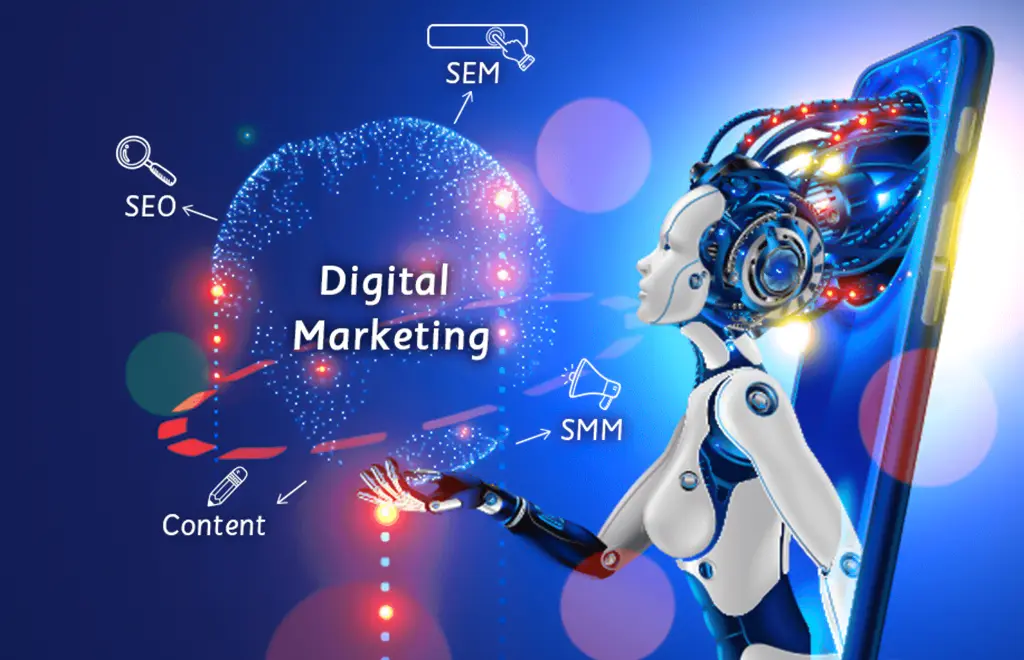
Imagine launching a digital campaign at 9 AM and seeing optimized results by noon — all without lifting a finger. This isn’t a futuristic fantasy; it’s today’s reality, thanks to the rise of AI in digital marketing. Artificial Intelligence is not just a buzzword anymore; it’s a foundational pillar reshaping how businesses connect with their audiences, convert leads, and create personalized experiences.
In this article, we’ll explore seven real-world AI tools and strategies transforming the marketing landscape, how to use them effectively, and what you need to stay competitive. Whether you’re a solopreneur, digital marketing manager, or business owner, these insights will show you how to blend human creativity with machine precision for powerful outcomes.
Why AI is Dominating the Digital Marketing Space
Before diving into the tools and strategies, it’s essential to understand the core reasons why AI has become such a dominant force.
-
Data Overload: Today’s marketers are inundated with data. AI can process and interpret massive datasets faster and more accurately than any human.
-
Real-time Optimization: AI enables campaigns to be optimized on the fly based on user behavior.
-
Hyper-Personalization: From email subject lines to product recommendations, AI crafts individualized experiences at scale.
-
Predictive Analytics: Machine learning models can forecast trends, customer behavior, and campaign outcomes.
Gartner predicts that by 2026, 80% of marketers who have invested in AI will see measurable improvements in customer engagement and campaign performance.
1. AI-Powered Content Creation and Optimization
One of the most transformative applications of AI in digital marketing is content creation. Tools like Jasper, Copy.ai, and Writesonic use advanced language models to help marketers craft blog posts, ads, and email copy quickly.
How it works:
-
You input a topic, tone, and length.
-
The AI suggests titles, outlines, and even full-length content.
-
Marketers can edit and refine the draft for human touch and branding.
These tools are especially useful for content scaling, brainstorming, and SEO optimization. Many now come with built-in keyword suggestion tools that align with Google’s latest ranking factors.
Pro Tip: Combine AI writing tools with SEO platforms like SurferSEO or Frase.io to ensure content is optimized for user intent and search engines alike.
2. Chatbots and Conversational AI
Modern consumers expect instant responses. Enter AI-powered chatbots like Drift, ManyChat, and Chatfuel. These tools help businesses automate customer service, lead generation, and even sales without requiring human agents around the clock.
Use Case:
-
E-commerce: Answer FAQs and recommend products.
-
SaaS: Qualify leads and book demos automatically.
-
Education: Provide course information and enrollment help 24/7.
Strategy Tip: Use conversational AI as the first line of interaction and escalate complex queries to human agents. This hybrid model improves customer satisfaction and reduces support costs.
3. Predictive Analytics and Customer Insights
AI tools like HubSpot’s AI-powered CRM, Salesforce Einstein, and Google Analytics 4 offer deep predictive insights into customer behavior. These platforms analyze patterns in user actions, purchase history, and engagement rates to predict:
-
Which leads are most likely to convert
-
What content users prefer
-
When a customer might churn
Strategic Application:
Use these predictions to personalize offers, retarget ads, and craft content strategies that align with customer intent.
Stat: According to Deloitte, predictive analytics users are twice as likely to achieve top-quartile performance in customer engagement metrics.
4. Visual Recognition and Creative Automation
Tools like Canva’s Magic Design, Lumen5, and Designs.ai utilize AI to generate video content, presentations, and social media creatives. These platforms remove the technical barriers to content creation and save marketers hours of design time.
Example:
-
Upload a blog post and convert it into a video summary using Lumen5.
-
Generate brand-consistent social posts from a simple product description.
This is particularly useful for small businesses and solo marketers who need high-quality visuals but lack a dedicated design team.
5. AI in Email Marketing
Email remains one of the highest ROI digital channels, and AI is enhancing its performance even further. Platforms like Mailchimp, ActiveCampaign, and Sender now use AI to:
-
Segment audiences
-
A/B test subject lines
-
Predict send times for maximum open rates
-
Recommend personalized product offerings
Actionable Tactic:
Use AI-generated content suggestions combined with behavioral triggers (e.g., abandoned carts, inactive users) to create highly effective drip campaigns.
6. AI for SEO and Voice Search Optimization
Search Engine Optimization (SEO) has evolved beyond just keywords and backlinks. With AI, marketers can now focus on search intent, voice queries, and semantic analysis.
Tools like MarketMuse, Clearscope, and Semrush’s AI Assistant help marketers:
-
Analyze SERPs
-
Identify content gaps
-
Optimize for long-tail and conversational queries
Voice Search Tip: Use AI to analyze how users speak versus type. Tools like AnswerThePublic or AlsoAsked provide phrasing that mirrors natural speech—critical for ranking in voice queries.
7. Social Media Listening and Sentiment Analysis
Understanding public sentiment in real-time allows brands to adjust messaging, monitor PR crises, and engage audiences proactively. Tools like Brand24, Sprinklr, and Hootsuite Insights use AI to analyze:
-
Brand mentions
-
Hashtag performance
-
Customer sentiment
Strategy:
Use sentiment insights to tweak ad messaging, respond to complaints quickly, and discover new content ideas based on trending discussions.
Example: A spike in positive sentiment during a campaign can be a signal to double your ad spend or expand the campaign reach.
Challenges and Ethical Considerations
While the rise of AI in digital marketing brings numerous benefits, there are some challenges to consider:
-
Data privacy: Always comply with GDPR, CCPA, and other privacy laws when collecting or analyzing user data.
-
Over-automation: Too much automation can make your brand feel impersonal. Balance machine efficiency with human empathy.
-
Bias in AI: Algorithms can unintentionally reinforce stereotypes if not monitored. Regular audits and inclusive data sets are crucial.
How to Get Started
For those looking to dive deeper, enrolling in a practical digital marketing course that covers AI tools and analytics is a smart move. The industry is evolving fast, and keeping up means continually upgrading your skills.
Start by:
-
Testing one AI tool (like Jasper or ChatGPT) for content creation
-
Automating a simple email campaign with AI segmentation
-
Setting up a chatbot on your landing page
Each step you take brings compounding improvements in performance and efficiency.
Final Thoughts
The rise of AI in digital marketing isn’t just about automation — it’s about augmentation. The most successful marketers in the next decade won’t be those who resist AI but those who master it. By combining creative strategy with AI-driven tools, you can scale your impact, deliver unforgettable experiences, and grow sustainably in a hyper-competitive digital landscape.
As the lines between human insight and machine intelligence blur, the key to success will lie in how well you balance both — to tell better stories, create smarter strategies, and achieve greater results.







